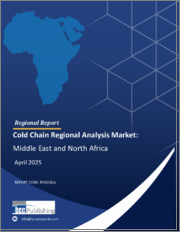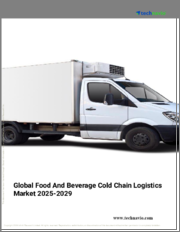
|
시장보고서
상품코드
1597568
일본의 콜드체인 물류 시장 : 동향 분석, 경쟁 구도, 예측-서비스 유형별, 온도 유형별, 최종 사용자별(2019-2030년)Japan Cold Chain Logistics Market, By Service Type; By Temperature Type; By End User, Trend Analysis, Competitive Landscape & Forecast, 2019-2030 |
||||||
일본의 콜드체인 물류 시장은 CAGR 5.6%로 확대될 전망이며, 2030년까지 270억 달러에 달할 전망입니다.
일본의 콜드체인 물류 시장은 신선식품에 대한 소비자 수요 증가와 고령자 인구 증가로 인한 편리한 식품 수요 증가에 따라 활황을 보이고 있습니다.
전략 컨설팅과 시장 조사의 대기업인 BlueWeave Consulting은 최근 조사에서 일본의 콜드체인 물류 시장 규모를 2023년에 207억 6,000만 달러로 평가했습니다. 2024년부터 2030년까지의 예측 기간 동안 밸류체인은 일본의 콜드체인 물류 시장 규모가 CAGR 5.60%로 확대되어 2030년에는 270억 달러에 달할 것으로 예측했습니다. 일본 콜드체인 물류 시장의 주요 성장 요인에는 편의점과 포장 식품의 인기가 포함됩니다. 일본의 상점은 '편의점'이라고 불리며 신선한 식재료와 우수한 품질로 다양한 상품을 제공하고 있으며, 효과적인 콜드체인 물류가 필요합니다. 더욱이 e커머스 분야의 성장과 구조화된 소매점 체인의 존재가 예측 기간 동안 일본의 콜드체인 물류 시장을 촉진할 것으로 예측됩니다.
기회-콜드체인 물류의 기술 진보
인공지능(AI), 사물인터넷(IoT), 블록체인 등 첨단 기술의 통합이 진행되고 있으며, 예측기간 중 일본 콜드체인 물류 시장의 성장을 크게 촉진할 것으로 예상됩니다. 선진 기술은 온도 관리 및 부패 감소 등 다양한 기능을 자동화하여 콜드체인 업무 효율성과 안전성 향상에 도움이 될 수 있습니다. 또한 콜드체인 물류의 자동 냉장 창고 및 전기자동차 시장 개척 및 투자는 지속 가능한 운영과 탄소 발자국을 줄이고 분석 기간 동안 일본의 콜드체인 물류 시장을 견인할 것으로 예측됩니다.
지정학적 긴장 증가가 일본 콜드체인 물류 시장에 미치는 영향
러시아·우크라이나 전쟁이나 중동 등, 세계 각지에서 지정학적 긴장이 높아지고 있어 일본의 콜드체인 물류 시장의 성장이 저해될 가능성이 있습니다. 일본은 폭넓은 완제품과 원재료를 수출입하고 있습니다. 그러나, 증세나 제재 조치 등의 무역 제한은 지정학적 대립의 결과로서 자주 발생해, 콜드체인 물류의 지연이나 고가 선적의 한 원인이 되고 있습니다. 특히 식품, 의약품, 의료기기 등 수요가 높은 품목에서는 추가 비용이 상품의 흐름에 큰 영향을 미칠 가능성이 있습니다. 게다가 콜드체인 물류의 운영에는 에너지가 필요합니다. 에너지 가격의 상승은 에너지 생산국의 긴장(중동이나 러시아·우크라이나 전쟁 등)에 기인할 가능성이 있으며, 특히 정온 트럭이나 항공화물의 수송비용에 영향을 줄 가능성이 있습니다.
냉동 부문이 2024년부터 2030년까지 가장 빠른 CAGR로 성장
일본의 콜드체인 물류 시장에서 가장 큰 점유율을 차지하는 것은 냉동 부문입니다. 일본은 바쁜 라이프 스타일을 보내는 소비자를 위해 쇠고기 슬라이스, 낫토, 타코야키, 생선, 만두 등 다양한 냉동 식품을 제공하고 있습니다. 일본에서는 급속 냉동 기술을 활용해 상품의 보존 기간을 늘리고, 고객이 제철이 되면 해동할 수 있도록 하고 있습니다. 이 기술로 냉동 과일이나 냉동 생선은 계절에 관계없이 일년 내내 소비할 수 있기 때문에 일본 시장에서 점점 인기가 높아지고 있습니다.
경쟁 구도
일본 콜드체인 물류 시장의 주요 업계 기업으로는 일본 통운, 야마토 홀딩스, 사가와 익스프레스, 긴테츠 익스프레스, 이토츄 로지스틱스 주식회사, DHL, Kuehne Nagel, Nichiirei Logistics Group, Inc., Sojitz Corporation, CEVA Logistics 등 여러 기업이 존재하기 때문에 시장 경쟁은 치열합니다.
이러한 기업들은 시장 점유율을 더욱 높이기 위해 M&A, 파트너십, 조인트 벤처, 라이선스 계약, 신제품 출시 등 다양한 전략을 채택하고 있습니다.
이 보고서의 상세한 분석을 통해 성장 가능성, 향후 동향, 일본의 콜드체인 물류 시장에 대한 정보를 제공합니다. 또한 총 시장 규모의 예측을 촉진하는 요인도 다루고 있습니다. 이 보고서는 일본 콜드체인 물류 시장의 최신 기술 동향과 업계에 대한 분석을 제공하고 의사 결정자가 건전한 전략적 의사 결정을 할 수 있도록 지원할 것을 약속합니다. 게다가 시장의 성장 촉진 요인, 과제 및 경쟁력에 대해서도 분석하고 있습니다.
목차
제1장 조사 프레임워크
제2장 주요 요약
제3장 일본의 콜드체인 물류 시장 인사이트
- 업계 밸류체인 분석
- DROC 분석
- 성장 촉진요인
- 신선한 식품에 대한 소비자 수요 증가
- 일본의 인구 고령화
- 엄격한 식품안전규제
- 억제요인
- 일본의 높은 운영 비용
- 엄격한 규제 및 규정 준수 요건
- 숙련 노동자의 부족
- 기회
- 선진기술 도입 확대
- 온라인 식료품 및 식품 배달 서비스의 대두
- 에너지 효율이 높은 기술이나 환경 친화적인 포장 등 지속 가능한 관행의 채용
- 과제
- 콜드체인 전체에서 일관된 온도 관리를 실현
- 일본의 인프라 노후화
- 성장 촉진요인
- 기술 진보 및 최근 동향
- 규제 프레임워크
- Porter's Five Forces 분석
제4장 일본의 콜드체인 물류 시장 : 마케팅 전략
제5장 일본의 콜드체인 물류 시장 : 가격 분석
제6장 일본의 콜드체인 물류 시장 개요
- 시장 규모와 예측(2019-2030년)
- 금액별
- 시장 점유율 및 예측
- 서비스 유형별
- 수송
- 창고 보관
- 패키지
- 감시
- 온도 유형별
- 냉장
- 냉동
- 최종 사용자별
- 식품 및 음료
- 의약품
- 생명공학
- 화학약품
- 기타
- 서비스 유형별
제7장 경쟁 구도
- 주요 기업과 제품 일람
- 일본의 콜드체인 물류 기업의 시장 점유율 분석(2023년)
- 경영 파라미터에 의한 경쟁 벤치마킹
- 주요 전략적 전개(합병, 인수, 제휴)
제8장 지정학적 긴장의 고조가 일본의 콜드체인 물류 시장에 미치는 영향
제9장 기업 프로파일(기업 개요, 재무 매트릭스, 경쟁 구도, 주요 인물, 주요 경쟁, 연락처, 전략 전망, SWOT 분석)
- Nippon Express
- Yamato Holdings Co. Ltd
- Sagawa Express Co. Ltd
- Kintetsu World Express(KWE)
- Itochu Logistics Corp.
- DHL
- Kuehne Nagel
- Nichirei Logistics Group, Inc.
- Sojitz Corporation
- CEVA Logistics
- 기타 주요 기업
제10장 주요 전략적 제안
제11장 조사 방법
AJY 24.12.05Japan Cold Chain Logistics Market Expands at 5.6% CAGR to Touch USD 27 Billion by 2030
Japan Cold Chain Logistics Market is flourishing because of the rising consumer demand for fresh food and growing elderly population propelling the demand for convenient food products.
BlueWeave Consulting, a leading strategic consulting and market research firm, in its recent study, estimated Japan Cold Chain Logistics Market size at USD 20.76 billion in 2023. During the forecast period between 2024 and 2030, BlueWeave expects Japan Cold Chain Logistics Market size to expand at a CAGR of 5.60% reaching a value of USD 27 billion by 2030. Major growth factors for Japan Cold Chain Logistics Market include the popularity of convenient and packaged food. Japanese convenience stores, known as konbini, provide a range of goods made with fresh ingredients and excellent quality, which necessitate effective cold chain logistics. Furthermore, it is projected that the growing e-commerce sector and the existence of structured retail store chains will propel Japan Cold Chain Logistics Market over the forecast period.
Opportunity - Technological Advancements in Cold Chain Logistics
The rising integration of advanced technologies, including artificial intelligence (AI), the Internet of Things (IoT), and blockchain, is anticipated to significantly drive the growth of Japan Cold Chain Logistics Market during the forecast period. Advanced technologies could help improve the efficiency and safety of cold chain operations by automating various functions, such as temperature control and reducing spoilage. In addition, developments and investments in automated refrigerated warehouses and electric vehicles in cold chain logistics for sustainable operations and reducing the carbon footprint are anticipated to drive Japan Cold Chain Logistics Market over the period in analysis.
Impact of Escalating Geopolitical Tensions on Japan Cold Chain Logistics Market
Intensifying geopolitical tensions in several parts of the world, such as Russia-Ukraine war and in the Middle East, could disrupt the growth of Japan Cold Chain Logistics Market. Japan imports and exports a wide range of finished goods and raw materials. However, trade restrictions like higher taxes and sanctions are frequently the result of geopolitical conflicts, which contributes to cold chain logistics delays and expensive shipping. Additional costs might have a big impact on the flow of commodities, especially for high-demand items like food items, medications, and medical equipment. Additionally, energy is necessary for cold chain logistics to operate. Higher energy prices can result from tensions in energy-producing countries (such as the Middle East or the Russia-Ukraine war), which can have an impact on transportation costs, especially for temperature-controlled trucks and air freight.
Frozen Segment to Grow at Fastest CAGR During 2024-2030
The frozen segment accounts for the largest share of Japan Cold Chain Logistics Market. Japan provides a large variety of frozen food items, such as sliced beef, natto, takoyaki, fish, and dumplings for its consumers with busy lifestyle. The country leverages rapid freezing technology to increase the shelf life of products, enabling customers to unfreeze them when they are ready to eat. Due to this technique, frozen fruits and fish are becoming increasingly popular in the Japanese market, as they can be consumed year-round, regardless of the season.
Competitive Landscape
The major industry players of Japan Cold Chain Logistics Market include Nippon Express, Yamato Holdings Co. Ltd, Sagawa Express Co. Ltd, Kintetsu World Express (KWE), Itochu Logistics Corp., DHL, Kuehne Nagel, Nichirei Logistics Group, Inc., Sojitz Corporation, and CEVA Logistics. The presence of several companies makes the market intensely competitive.
These companies employ various strategies, including mergers and acquisitions, partnerships, joint ventures, license agreements, and new product launches, to further enhance their market share.
The in-depth analysis of the report provides information about growth potential, upcoming trends, and Japan Cold Chain Logistics Market. It also highlights the factors driving forecasts of total market size. The report promises to provide recent technology trends in Japan Cold Chain Logistics Market and industry insights to help decision-makers make sound strategic decisions. Furthermore, the report also analyzes the growth drivers, challenges, and competitive dynamics of the market.
Table of Contents
1. Research Framework
- 1.1. Research Objective
- 1.2. Product Overview
- 1.3. Market Segmentation
2. Executive Summary
3. Japan Cold Chain Logistics Market Insights
- 3.1. Industry Value Chain Analysis
- 3.2. DROC Analysis
- 3.2.1. Growth Drivers
- 3.2.1.1. Rising Consumer Demand for Fresh Food
- 3.2.1.2. Aging Population in Japan
- 3.2.1.3. Stringent Food Safety Regulations
- 3.2.2. Restraints
- 3.2.2.1. High Operating Costs in Japan
- 3.2.2.2. Strict Regulations and Compliance Requirements
- 3.2.2.3. Limited Availability of Skilled Labor
- 3.2.3. Opportunities
- 3.2.3.1. Increasing Adoption of Advanced Technologies
- 3.2.3.2. Rise of Online Grocery and Food Delivery Services
- 3.2.3.3. Adopting Sustainable Practices, such as Energy-Efficient Technologies and Eco-Friendly Packaging
- 3.2.4. Challenges
- 3.2.4.1. Ensuring Consistent Temperature Control throughout the Cold Chain
- 3.2.4.2. Aging Infrastructure in Japan
- 3.2.1. Growth Drivers
- 3.3. Technological Advancements/Recent Developments
- 3.4. Regulatory Framework
- 3.5. Porter's Five Forces Analysis
- 3.5.1. Bargaining Power of Suppliers
- 3.5.2. Bargaining Power of Buyers
- 3.5.3. Threat of New Entrants
- 3.5.4. Threat of Substitutes
- 3.5.5. Intensity of Rivalry
4. Japan Cold Chain Logistics Market: Marketing Strategies
5. Japan Cold Chain Logistics Market: Pricing Analysis
6. Japan Cold Chain Logistics Market Overview
- 6.1. Market Size & Forecast, 2019-2030
- 6.1.1. By Value (USD Billion)
- 6.2. Market Share & Forecast
- 6.2.1. By Service Type
- 6.2.1.1. Transportation
- 6.2.1.2. Warehousing
- 6.2.1.3. Packaging
- 6.2.1.4. Monitoring
- 6.2.2. By Temperature Type
- 6.2.2.1. Chilled
- 6.2.2.2. Frozen
- 6.2.3. By End User
- 6.2.3.1. Food & Beverages
- 6.2.3.2. Pharmaceuticals
- 6.2.3.3. Biotechnology
- 6.2.3.4. Chemicals
- 6.2.3.5. Others
- 6.2.1. By Service Type
7. Competitive Landscape
- 7.1. List of Key Players and Their Products
- 7.2. Japan Cold Chain Logistics Company Market Share Analysis, 2023
- 7.3. Competitive Benchmarking, By Operating Parameters
- 7.4. Key Strategic Developments (Mergers, Acquisitions, Partnerships)
8. Impact of Escalating Geopolitical Tensions on Japan Cold Chain Logistics Market
9. Company Profiles (Company Overview, Financial Matrix, Competitive landscape, Key Personnel, Key Competitors, Contact Address, and Strategic Outlook, and SWOT Analysis)
- 9.1. Nippon Express
- 9.2. Yamato Holdings Co. Ltd
- 9.3. Sagawa Express Co. Ltd
- 9.4. Kintetsu World Express (KWE)
- 9.5. Itochu Logistics Corp.
- 9.6. DHL
- 9.7. Kuehne Nagel
- 9.8. Nichirei Logistics Group, Inc.
- 9.9. Sojitz Corporation
- 9.10. CEVA Logistics
- 9.11. Other prominent players
10. Key Strategic Recommendations
11. Research Methodology
- 11.1. Qualitative Research
- 11.1.1. Primary & Secondary Research
- 11.2. Quantitative Research
- 11.3. Market Breakdown & Data Triangulation
- 11.3.1. Secondary Research
- 11.3.2. Primary Research
- 11.4. Breakdown of Primary Research Respondents
- 11.5. Assumptions & Limitations
*Financial information of non-listed companies can be provided as per availability.
**The segmentation and the companies are subject to modifications based on in-depth secondary research for the final deliverable.



















